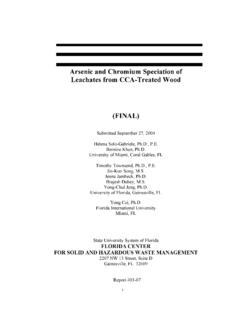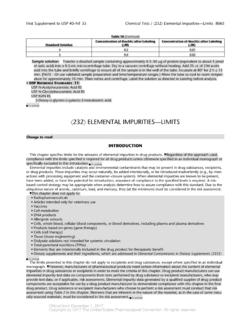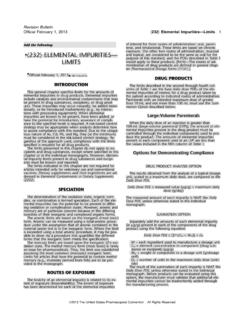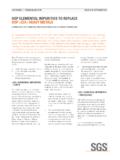Transcription of UNDERSTANDING VARIATION IN PARTITION …
1 United States Office of Air and Radiation EPA 402-R-04-002 CEnvironmental Protection Agency July 2004 UNDERSTANDING VARIATION INPARTITION COEFFICIENT, Kd, VALUESV olume III:Review of Geochemistry and Available Kd Values for Americium, Arsenic, Curium, Iodine, Neptunium, Radium, and TechnetiumiUNDERSTANDING THE VARIATION INPARTITION COEFFICIENT, Kd, VALUESV olume III:Review of Geochemistry and Available Kd Values for Americium, Arsenic, Curium, Iodine,Neptunium, Radium, and TechnetiumJuly 2004 Interagency Agreement No. DW89937220-01-7 Project OfficerRonald G. WilhelmOffice of Radiation and Indoor Environmental Protection AgencyWashington, 20460iiNOTICEThe following report is intended solely as guidance to EPA and other environmental document does not constitute rulemaking by the Agency, and cannot be relied on to create asubstantive or procedural right enforceable by any party in litigation with the United States.
2 EPA maytake action that is at variance with the information, policies, and procedures in this document and maychange them at any time without public herein to any specific commercial products, process, or service by trade name, trademark,manufacturer, or otherwise, does not necessarily constitute or imply its endorsement, recommendation,or favoring by the United States the long-term behavior of contaminants in the subsurface is becoming increasinglyimportant as the nation addresses groundwater contamination. Groundwater contamination is anational concern as about 50 percent of the United States population receives its drinking water fromgroundwater. It is the goal of the Environmental Protection Agency (EPA) to prevent adverse effectsto human health and the environment and to protect the environmental integrity of the nation groundwater is contaminated, it is important to understand how the contaminant moves inthe subsurface environment.
3 Proper UNDERSTANDING of the contaminant fate and transport is necessaryin order to characterize the risks associated with the contamination and to develop, when necessary,emergency or remedial action plans. The parameter known as the PARTITION (or distribution) coefficient(Kd) is one of the most important parameters used in estimating the migration potential ofcontaminants present in aqueous solutions in contact with surface, subsurface and suspended is the third volume in the series that describes: (1) the conceptualization, measurement, anduse of the PARTITION coefficient parameter; and (2) the geochemical aqueous solution and sorbentproperties that are most important in controlling adsorption/retardation behavior of selectedcontaminants. Volumes I and II were published in 1999. Volume I of this document focuses onproviding EPA and other environmental remediation professionals with a reasoned and documenteddiscussion of the major issues related to the selection and measurement of the PARTITION coefficient for aselect group of contaminants.
4 The selected contaminants investigated in Volume II of this documentinclude: chromium, cadmium, cesium, lead, plutonium, radon, strontium, thorium, tritium (3H), anduranium. The contaminants discussed in Volume III include: americium, arsenic, curium, iodine,neptunium, radium, and technetium. This three-volume report also addresses a void that has existed onthis subject in both this Agency and in the user is important to note that soil scientists and geochemists knowledgeable of sorption processes innatural environments have long known that generic or default PARTITION coefficient values found in theliterature can result in significant errors when used to predict the impacts of contaminant migration orsite-remediation options. Accordingly, one of the major recommendations of this report is that forsite-specific calculations, PARTITION coefficient values measured at site-specific conditions are those cases when the PARTITION coefficient parameter is not or cannot be measured, Volumes IIand III of this document: (1) provide a thumb-nail sketch of the key geochemical processes affectingthe sorption of the selected contaminants; (2) provide references to related key experimental and reviewarticles for further reading; (3) identify the important aqueous- and solid-phase parameters controllingthe sorption of these contaminants in the subsurface environment under oxidizing conditions.
5 And (4)identify, when possible, minimum and maximum conservative PARTITION coefficient values for eachcontaminant as a function of the key geochemical processes affecting their addition, this publication is produced as part of ORIA s long-term strategic plan to assist in theremediation of contaminated sites. It is published and made available to assist all environmentalremediation professionals in the cleanup of groundwater sources all over the United A. Cotsworth, DirectorOffice of Radiation and Indoor AirvACKNOWLEDGMENTSR onald G. Wilhelm from ORIA s Center for Radiation Site Cleanup was the project lead and EPAP roject Officer for this three-volume report. Project support was provided by EPA s Office ofSuperfund Remediation and Technology Innovation (OSRTI). EPA/ORIA wishes to thank the following people for their assistance and technical reviewcomments on various drafts of this report: Paul M.
6 Bertsch, Savannah River Ecology LaboratoryPatrick V. Brady, DOE, Sandia National LaboratoriesDaniel I. Kaplan, Westinghouse Savannah River CompanyDavid M. Kargbo, Temple UniversityIrma McKnight, EPA, Office of Radiation and Indoor AirAndrew Sowder, Savannah River Ecology LaboratoryIn addition, a special thanks goes to Lindsey Bender from ORIA s Radiation Protection Division,for her contributions in the production of this authorship of this guide was provided by the Department of Energy s Pacific NorthwestNational Laboratory (PNNL) under the Interagency Agreement Number DW89937220-01-07. Lynnette Downing served as the Department of Energy s Project Officer for this InteragencyAgreement. PNNL authors involved in preparation of Volume III include:Kenneth M. KrupkaR. Jeffrey SerneviTO COMMENT ON THIS GUIDE OR PROVIDE INFORMATION FOR FUTURE UPDATESSend all comments/updates Environmental Protection AgencyOffice of Radiation and Indoor AirAttention: UNDERSTANDING VARIATION in PARTITION (Kd ) Values1200 Pennsylvania Avenue, (6608J)Washington, volumes (EPA, 1999b,1999c) can be downloaded and printed over the Internet at: This is found in the EPA Radiation, Information,Radiation Publications, Topical Publications, Protecting People and the Environment, Fate & Transportsections of the web three-volume report describes the conceptualization, measurement, and use of the PARTITION (or distribution) coefficient, Kd, parameter, and the geochemical aqueous solution and sorbentproperties that are most important in controlling adsorption/retardation behavior of selectedcontaminants.
7 The report is provided for technical staff from EPA and other organizations who areresponsible for prioritizing site remediation and waste management decisions. Volumes I and II werepublished by the EPA in Volume I focuses on the Kd concept and methods for measurement ofKd values. Particular attention is directed at providing an UNDERSTANDING of: (1) the use of Kd values informulating retardation factor (Rf ), (2) the difference between the original thermodynamic Kdparameter derived from ion-exchange literature and its empiricized use in contaminant transportcodes, and (3) the explicit and implicit assumptions underlying the use of the Kd parameter incontaminant transport codes. A conceptual overview of chemical reaction models and their use inaddressing technical defensibility issues associated with data from Kd studies is also presented.
8 Volumes II and III provide thumb-nail sketches of the important aqueous speciation,coprecipitation/dissolution, and adsorption processes affecting the sorption of selected inorganiccontaminants under oxidizing conditions. The Kd values listed in the literature for these contaminantsare also summarized. The contaminants discussed in Volume II include chromium, cadmium, cesium,lead, plutonium, radon, strontium, thorium, tritium (3H), and uranium. Volume III, which is anextension of Volume II, includes reviews of the sorption of americium, arsenic, curium, iodine,neptunium, radium, and technetium. However, due to the limited number of Kd adsorption studies forthese contaminates and the large uncertainty, conservative minimum and maximums were not included. References to related key experimental and review articles are included for possible further reading.
9 CONTENTSPageNOTICE .. iiFOREWORD .. iiiACKNOWLEDGMENTS .. vFUTURE UPDATES .. viiLIST OF FIGURES .. xiiLIST OF TABLES .. The Kd Methods, Issues, and Criteria for Measuring Kd Laboratory Batch Laboratory Flow-Through Other Issues .. Application of Chemical Reaction Contaminant Geochemistry and Kd Values .. Americium Geochemistry and Kd Values .. Overview: Important Aqueous- and Solid-Phase Parameters Controlling Retardation .. General Aqueous Dissolution/Precipitation/Coprecipitatio n .. Guidance for Screening Calculations of General Adsorption Kd Studies for Americium on Soil Materials .. Published Compilations Containing Kd Values for Americium .. Kd Studies of Americium on Pure Mineral, Oxide, and Crushed Rock Materials .. Arsenic Geochemistry and Kd Values.
10 Overview: Important Aqueous- and Solid-Phase Parameters Controlling Retardation .. General Aqueous Dissolution/Precipitation/Coprecipitatio n .. Guidance for Screening Calculations of General Adsorption Kd Studies for Arsenic on Soil Materials .. Published Compilations Containing Kd Values for Arsenic .. Kd Studies of Arsenic on Pure Mineral, Oxide, andCrushed Rock Materials .. Curium Geochemistry and Kd Values .. Overview: Important Aqueous- and Solid-Phase Parameters Controlling Retardation .. General Aqueous Dissolution/Precipitation/Coprecipitatio n .. Guidance for Screening Calculations of General Adsorption Kd Studies for Curium on Soil Materials .. Published Compilations Containing Kd Values for Curium .. Kd Studies of Curium on Pure Mineral, Oxide, andCrushed Rock Materials.















